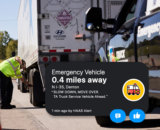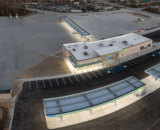After a NATSO member asked me how she could drive more RV traffic to her travel center, I sat down with a friend who has spent the better part of four years and accumulated more than 100,000 miles traveling the country in a diesel-powered pickup towing a 30-foot travel trailer to learn more about his life on the road.
He shared his experiences and made some recommendations for how truckstops and travel plazas could better serve RVers. He had a lot of great stuff to share! (See 8 Tips to Better Serve RV Customers at Your Truckstop.)
Here are seven more recommendations on how to attract and serve RV traffic.
1. Opportunities for Inside Sales: Many RVers can and do use the restrooms in their rigs. If you had your bathroom with you, why wouldn’t you use it? So retailers can’t count on RV customers coming in for the restrooms. They need something else to lure them inside, which wouldn’t be hard. Maybe it’s pump toppers that advertise RV supplies. Maybe it’s grocery items (remember, they’ve got kitchens and fridges with them too). There are so many fewer places RVers can go and be able to fit or park compared to four-wheel travelers, so if they’re someplace fueling that can fit their rig, it’s not hard to convince them to come in the store or restaurant and take full advantage of the stop.
2. Clear Signage: Two words: potable water. If you offer it, label it, promote it, and make it easy to get to with a 50-70 foot pickup+trailer or motorhome+towed car rig. “Often I’ll see water spigots on the fuel island or by the air pumps, but I don’t know if they’re potable water and I don’t know if I’m allowed to use it to top off my water tank or fill a portable seven-gallon jug,” my friend said.
3. Overnight RV Parking Considerations. Lots of RVers sleep in Walmart parking lots. If you’re arriving late and leaving early, it sometimes doesn’t make sense to pay $50 for a campground when you can stay literally anywhere with all the luxuries of home. Many trailers and motorhomes are fully self-contained, so travelers can park and sleep anywhere and enjoy a hot shower, cook a meal, etc.
Walmart is popular because many locations encourage overnight RV guests. “Most full-time RVers I know make a point to go into the Walmart to buy something as a way to say thank you,” my friend said. “Some RVers sleep at truckstops and rest areas, but it’s not ideal because you worry about taking a spot from a professional driver.”
If a truckstop lot were big enough, a dedicated few spaces (labeled) for overnight RVs would be an attractive alternative to Walmart. Not sure if that’s feasible, but Walmart has done well by welcoming these customers. It’s not uncommon to find a dozen trucks and two dozen RVs sleeping in a Walmart lot near an interstate exit every night of the week. If a travel plaza adds overnight RV spaces, remember that a lot of RVs have slideouts. Many times you can’t even get inside the trailer or the living space of the motorhome without extending the slides. Slides out, these vehicles are wider than a semi, so the RV spaces should be a few feet wider to accommodate.
4. Publicize RV Offerings Including Parking. Mobile apps such as AllStays and Campendium are two of the go-to sources for full-time RVers to research where they can stop, where they can dump, where they can fill water and buy propane, and where they are allowed to stay overnight. Walmarts and Cracker Barrels are known among RVers as two of the most RV-friendly Interstate businesses are all listed, plus they include info on how many RV spaces, which side of the building the spaces are on, and whether overnighting is allowed. Truckstops are mostly all listed, but most are missing RV amenities and overnight parking data.
5. Offer Electricity. Full-time RVers who avoid campgrounds in favor of state parks or national lands without amenities often have solar panels to charge their batteries. The onboard batteries are deep cycle and can power the fridge, an inverter for TVs and computers, the propane heater, the water pump for taking a shower, etc. Sometimes they run low due to excessive cloudy or rainy days, for example, and need to charge with shore power (anywhere from a 110-volt standard outlet to a 220 RV outlet with 30 or 50 amp service).
My friend said the he only saw a travel plaza parking lot with RV electrical hookups once. It was pay by the hour. He often wished more places had those.
“Maybe they’re not money makers. I’m just speaking from a ‘needs’ standpoint,” he said. “If an RVer could pay $10 or $15 and stay at a travel plaza where they could charge batteries, get some intensive computer work done, and enjoy a few hours or overnight of shore power versus having to go spend $30-$80 or more to unhook and setup at a campground to get the same thing, most would prefer the former. Sometimes you just want to be in-and-out, and campgrounds aren’t often a quick in-out proposition.”
6. Laundry is a Big Deal and a Huge Pain for RVers. The ideal scenario when living on the road or on a long cross-country family trip is to find a campground with a huge, nice laundry room, my friend said. “Good luck,” he added. “There are some, but often there are a few lousy machines that 100 other campers are fighting for. You could go into town and do laundry, but not with your rig.”
If only there were a place on the interstate with a big parking lot where you could park, do multiple loads while you work or relax or restock with supplies. Luckily, there is—travel plazas. From the truckstop point of view, there are fewer long-haul truckers, and more and more drivers go home at night. Truckstop laundry rooms aren’t as easy as a theater room or game room to convert into other uses to match the changing needs of professional drivers. Since you can’t turn your laundry room into something else, you need to find new customers who need to do laundry on the road. Luckily there is a huge potential customer base out there who have no idea that you have washers and dryers. Get the word out.
RVers, like truckers, need fuel, food and parking near major highways. Like truck drivers, RV drivers can’t park just anywhere. Locations offering dump stations, fresh water, laundry and propane have unknowingly already done the hard work to attract RVers, yet they’re not capitalizing on it.
Minimally, operators should:
(a) ensure they have signage at the location and perhaps on a billboard,
(b) check with AllStays and Campendium to be sure that listings are accurate; and
(c) stock basic RV supplies.
And remember, while RVers can be seniors, more and more are young couples and families with kids who live on the road, so consider the demographics when thinking about what products can appeal to them.
Subscribe to Updates
NATSO provides a breadth of information created to strengthen travel plazas’ ability to meet the needs of the travelling public in an age of disruption. This includes knowledge filled blog posts, articles and publications. If you would like to receive a digest of blog post and articles directly in your inbox, please provide your name, email and the frequency of the updates you want to receive the email digest.


